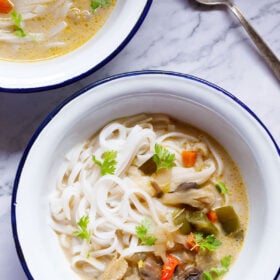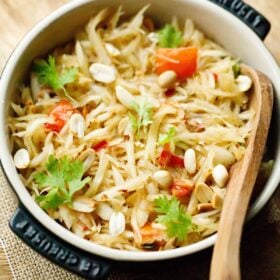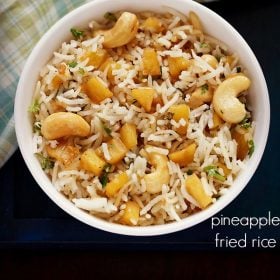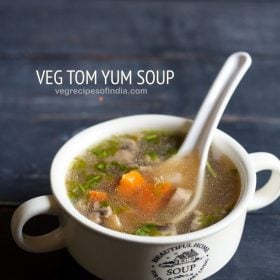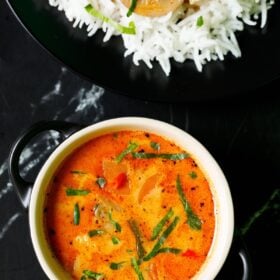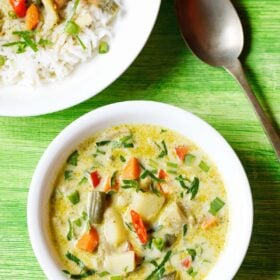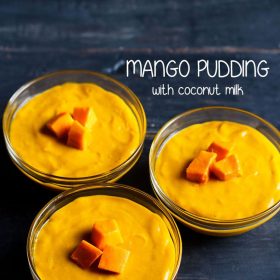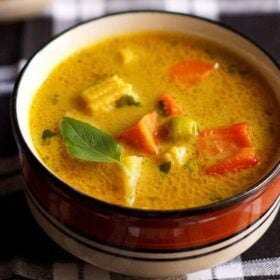When it comes to the cuisines of South East Asia or Oriental, Thai happens to be a personal favorite. Not just mine, Thai food is a family favorite too. So, here’s the vegetarian as well as vegan version of a spicy Thai Yellow Curry made with coconut milk, a mix of vegetables, Thai herbs and spices. The recipe of the yellow curry paste that gives this curry the distinct color and taste is also mentioned in this post. It is best to make this paste at home and use it for this curry. Pair it with steamed rice or jasmine rice, and enjoy a lovely weekend lunch meal.
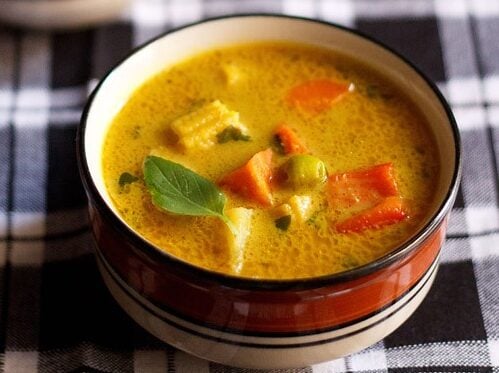
Table of Contents
About Thai Yellow Curry
Different types of curries are a significant part of the Thai food culture. This Thai Yellow Curry is one of the popular ones when it comes to Thai curries.
The fact that I have turned the original non-vegetarian recipe into a vegetarian and vegan one, also makes this recipe worth a try.
Not just Thai Yellow Curry, but for any curry in Thai cuisine, there are special types of paste that go into the curry.
The paste is what is responsible to impart the particular color to the curry as well as bring in the unique flavors too.
In the market, you may come across readymade packets of these pastes that can be used in the various curries as well as this Thai Yellow Curry too.
However, I will always suggest to make the curry pastes at home. Results in a better tasting and more wholesome curry, without a doubt.
In this Thai Yellow Curry as well, the making of the yellow curry paste is a crucial part of the entire recipe.
For this specific paste, you would require onion or shallots, coriander seeds, cumin seeds, black pepper, turmeric powder, bird’s eye chilies, galangal, garlic, kaffir lime leaves, lemongrass, lemon zest and coconut milk.
Preparing this yellow curry paste is easy. You just have to dunk in all the above mentioned ingredients in grinder or blender jar and give it a blitz. A smooth curry paste is what you will achieve that can be added to this Thai Yellow Curry.
About My Recipe
Since my recipe of Thai Yellow Curry is vegetarian and vegan, all the ingredients that are used in it as well as the curry paste are plant-based. I also add an array of veggies in it.
My personal choice of vegetables for this Thai Yellow Curry are broccoli or cauliflower, carrots, green beans, baby corn, Thai or pea brinjals and bell peppers.
I also add some button mushrooms for an umami touch. You can add more veggies and your choice of vegetables too.
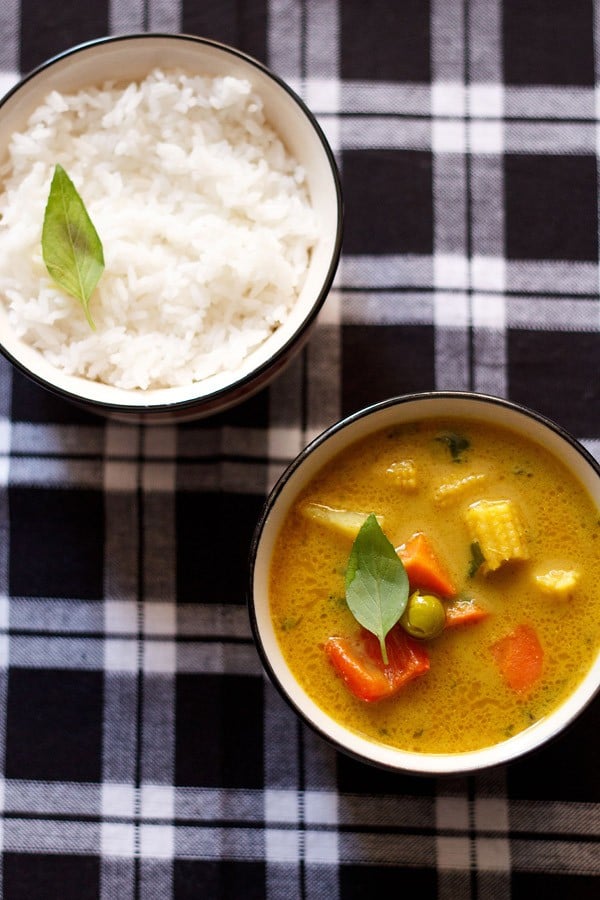
Since I love Thai cuisine, I have tried many a times at restaurants and eateries outside. But I would always prefer the homecooked one.
Restaurants in India sometimes serve Thai food that is a mish-mash with Chinese food. So, it is better to cook Thai food at home as it would be very close to the authentic versions.
We like the spicy Thai curries and at times I make them at home too. The use of coconut milk in these curries remind me much of the Goan and Mangalorean curries.
Along with this Thai Yellow Curry, I already have the recipes of Thai Red Curry and Thai Green Curry posted on the blog.
Thai Yellow Curry Essentials
Whenever you make Thai food at home, make sure to use the authentic Thai herbs like galangal, kaffir lime leaves, lemongrass stalks and Thai basil.
Galangal, kaffir lime leaves and lemongrass cannot be substituted if you want the authentic original Thai flavor and mouthfeel. This is true for this recipe of Thai Yellow Curry too.
If you are ready to compromise, then, ginger and lemon zest can be added as substitutes for these. But the taste will change considerably. I know It, since I have also made Thai curry many times with these substitutes.
Thai basil also has a delicate aroma as compared to Italian basil, which is more aromatic. You can use Italian basil instead of Thai basil in this Thai Yellow Curry too. Like I mentioned earlier, the veggies in this recipe can be of your choice.
Whenever I am making this Thai Yellow Curry or any other Thai curry, I purchase the Thai kit as well as galangal from a nearby super store.
These Thai herbs are grown in India, locally and not imported. In my own terrace garden, I have lemongrass and Thai basil. I also add the galangal to the morning tea. We love the flavor in our tea.
As I said earlier, you should make the yellow curry paste for this recipe. The typical yellow hue of the curry paste is due to the addition of turmeric in it.
For the coconut milk too, if using homemade, use thick coconut milk and not the thin one. Other choice is to use a canned coconut milk.
Ingredient Substitutes
Following are the alternative ingredient choices that can be used in place of the Thai herbs that are not available:
- Fresh ginger in place of galangal
- Lime leaves or lemon zest in place of kaffir lime leaves
- Fresh red chilies or dried red chilies in place of Thai chilies or bird’s eye chilies
- Small onions in place of shallots
- Italian basil in place of Thai basil
However, there is no substitute for lemongrass in this Thai Yellow Curry. If you don’t have it or are unable to source it, then probably just make the curry with zest of lemon.
More Thai Style Recipes To Try!
Soup Recipes
Thai Recipes
Rice Recipes
Soup Recipes
Please be sure to rate the recipe in the recipe card or leave a comment below if you have made it. For more vegetarian inspirations, Sign Up for my emails or follow me on Instagram, Youtube, Facebook, Pinterest or Twitter.
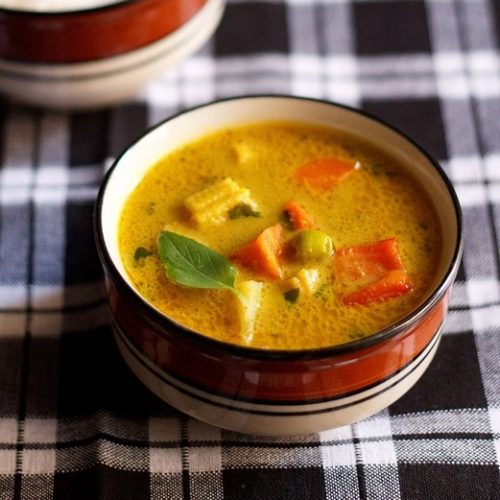
Thai Yellow Curry
Ingredients
Ingredients for thai yellow curry
- 1 carrot – small to medium, chopped
- 8 to 10 baby corn – chopped
- 5 to 6 button mushrooms – chopped
- 1 red bell pepper – small to medium chopped (capsicum), add any colored capsicum or bell pepper
- 10 to 12 pea eggplants (small thai eggplants)
- 1 cup Coconut Milk (Thick)
- ½ teaspoon raw sugar or palm sugar
- 1 tablespoon thai basil – chopped
- 1 or 2 teaspoon soy sauce – naturally brewed
- 1.5 to 2 cups water or vegetable stock, add as required
- 2 tablespoons coconut oil or vegetable oil
- 1 tablespoon thai basil – for garnish
- salt as required
For the yellow curry paste
- 1 onion – small sized, or 1 to 2 shallots – chopped
- 2 teaspoons coriander seeds
- 2 teaspoons cumin seeds or ground cumin
- ¼ teaspoon black peppercorns
- 1 teaspoon turmeric powder (ground turmeric), *check point 1 in notes below
- 2 bird eyes chillies – chopped
- 1 inch galangal – peeled and chopped, substitute ginger if you don't have galangal
- 2 to 3 garlic cloves – medium-sized, peeled and roughly chopped
- 2 tablespoons Coconut Milk
- 2 kaffir lime leaves – medium-sized, roughly chopped (substitute ½ teaspoon of lemon zest)
- 1 stalk of lemon grass – chopped (skip if not available)
- ½ teaspoon lemon zest – optional
Instructions
Preparing thai yellow curry paste
- Add all the ingrdedients for the paste in a small mixer-grinder jar or a small blender.
- Blitz to make a smooth paste. I prefer to make a smooth paste so that the galangal and lemon grass bits and pieces don't come in the way while eating.
- Keep the yellow curry paste aside.
Making thai yellow curry
- In a pot or pan, heat oil. Keep heat to a low. When the oil becomes hot, add all of the yellow curry paste in oil and sauté for 2 to 3 mins.
- Next add ½ cup coconut milk and sauté for 2 to 3 mins.
- Then add the chopped veggies and mushrooms and stir well.
- Add 1.5 to 2 cups water or vegetable stock, sugar and salt. Mix well and cover the pan.
- Simmer the veggies till they are almost cooked and tender.
- Then add the remaining ½ cup coconut milk.
- Stir and add soy sauce. Cover and cook for about 5 to 6 minutes more.
- Lastly add the chopped basil leaves and cook for half or one minute more.
- You can garnish the curry with some thai basil leaves.
- Serve Thai Yellow Curry with steamed jasmine rice or basmati rice.
Notes
Recipe Notes
- *Note that 1 teaspoon turmeric powder gives a dark yellow color, whereas you can add ½ teaspoon which will give a light yellow color.
- Add your preferred veggies. Some nice options are broccoli, cauliflower, green beans or french beans, carrots, baby corn, bell peppers and zucchini.
- Instead of pea eggplants, you can also include 2 to 3 small to medium-sized eggplants or brinjals.
- For the mushrooms, cremini, button and oyster mushrooms work well.
- For a thicker consistency, add less water while cooking the veggies.
- Simmer and cook veggies until they are almost tender and cooked. Do not overcook the veggies and make them mushy.
*Substitutes for the Thai herbs
- Galangal: Use ginger instead
- Kaffir lime leaves: Add lime leaves or zest of lemon instead
- Birds eye chilies: Substitute 1 fresh small red chilli or half of a Thai chilli or add 1 to 2 small to medium-sized dry red chilies. Remove the seeds from dried chillies if using.
- Shallots: Use small onions instead
- Lemon grass: No substitute. At the most, you could just do away with the zest of lemon
- Thai basil: Use Italian basil as a substitute.
Nutrition Info (Approximate Values)
This Thai Yellow Curry recipe from the archives, originally published in June 2014 has been updated and republished on February 2023.
